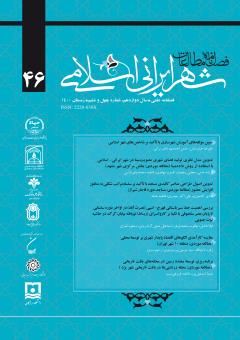تدوین مدل نظری تولید فضای شهری معنویتمبنا در شهر ایرانی- اسلامی با استفاده از روش دادهمبنا (مطالعه موردی: بخش مرکزی شهر مشهد)
محورهای موضوعی : شهرسازی اسلامی
فرزانه مدنی
1
,
مجتبی رفیعیان
2
,
افسون مهدوی
3
![]() ,
فاطمه محمد نیای قرایی
4
,
فاطمه محمد نیای قرایی
4
1 - دکتری شهرسازی، دانشگاه آزاد اسلامی مشهد
2 - استاد گروه شهرسازی، دانشگاه تربیت مدرس
3 - استادیار گروه شهرسازی، دانشگاه آزاد اسلامی کرمان
4 - استادیار گروه شهرسازی، واحد مشهد دانشگاه آزاد اسلامی مشهد
کلید واژه: تولید فضای شهری, شهرسازی معنویت¬مبنا, روش داده¬مبنا, کلان¬شهر و نمونه موردی مشهد,
چکیده مقاله :
توسعه شهری و فرایند تولید فضا همواره با تعارضات جدی توأم بوده است. این امر منجر به تولید و بازتولید فضاهای سوداگرانه مبتنی بر منطق صرف انباشت سرمایه شده است. از جمله نمودهای این تقابل را می توان در مداخلات صورت گرفته در بافتهای با هویت ویژه، چون مشهد دید، که در تعارض جدی با مباحث پایداری و ابعاد سه گانه آن است. در تقابل با این چالشها، شهرسازی معنویتمبنا و لزوم شناسایی شاخصهای آن در برنامه ریزی شهری معاصر در جهت تعادل بخشی، ضروری به نظر میرسد. روند افزایشی پژوهشها در این زمینه از سوی مراکز علمی معتبر بیانگر لزوم هرچه بیشتر کاربست این مفهوم در مقیاس برنامه ریزی شهری معاصر است. این پژوهش با هدف ارائه خوانشی مکانی از شاخصهای تولید فضای شهری معنویت مبنا در برنامه ریزی شهری معاصر در راستای تعدیل چرخه فعلی، با هدف تدوین اجزا و مؤلفههای مکانی مؤثر در تولید فضای شهری معنویت مبناست. این پژوهش به لحاظ هدف در زمره تحقیقات توسعهای و از نوع کیفی است که با روش نظریۀ داده بنیاد انجام شده است. جامعۀآماری شامل خبرگان و مطلعین کلیدی (21 مصاحبه فردی و 2 مصاحبه گروهی) که با استفاده از شیوۀ نمونه گیری هدفمند به عنوان حجم نمونه انتخاب شد. یافتههای تحقیق، شناسایی 23شاخص در قالب 8 بعد اصلی شامل چیدمان فضا، نقش انگیزی، نمادگرایی، پایداری، عدالت، امنیت، ساختار مدیریتی و معاصرسازی دانش نظری است. دستاورد این پژوهش، جای-گذاری مفهومی تعادل بخش به چرخه تولید فضاست که با ساختارسازی مؤلفههای مکانی مؤثر در تولید فضای معنویت مبنا، باعث ارتقای کیفی مداخلات؛خلق ارزش و نیل به پایداری توسعه خواهد شد.
Urban development and the process of space production have always been accompanied by serious conflicts. This has led to the production and reproduction of profit spaces based on the logic of capital accumulation. One of the manifestations of this confrontation can be seen in the interventions made in contexts of special identity, such as Mashhad, which is in serious conflict with the issues of sustainability and its three dimensions. Against these challenges, spiritual-led urbanism and the need to identification its indicators in contemporary urban planning in order to balance the current vicious cycle seem necessary. The increasing trend of researches in this field by reputable scientific centers shows the need to apply this concept more and more in the scale of contemporary urban planning. This research aims to provide a spatial reading of the indicators of the production of spiritual-led urban space in contemporary urban planning in line with the adjustment of the current cycle, with the aim of compiling effective spatial components in this process. In terms of the goal, this research is among developmental and qualitative research that was conducted with the grounded theory method. The statistical community includes experts and key informants (21 individual interviews and 2 group interviews) who were selected as the sample size using the purposeful sampling method. The findings of the research are the identification of 23 indicators in the form of 8 main dimensions, including space syntax, role-playing, symbolism, sustainability, and justice, security, and management structure and Contemporizationof theoretical knowledge. The achievement of this research is placing a balancing concept in the cycle of space production, which will reduce the ambiguities and shortcomings of the urban planning system, especially in cities with the support of spiritual identity, by structuring effective spatial components in the production of spiritual-led space.
